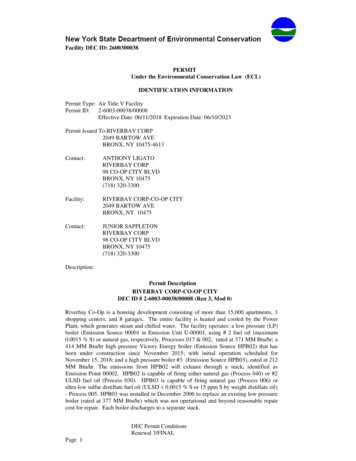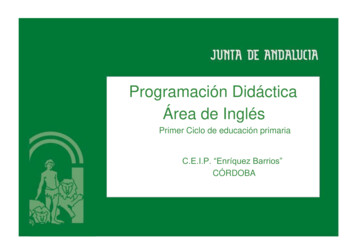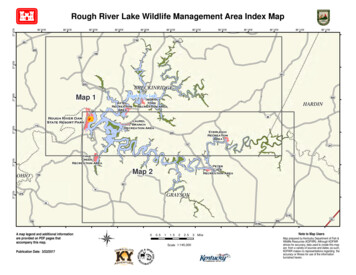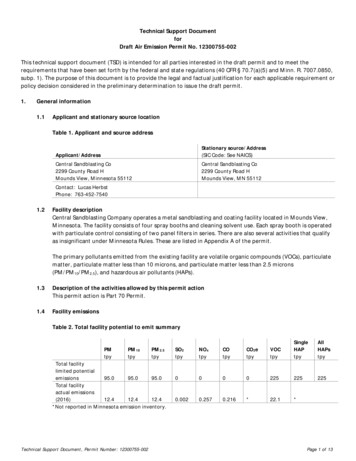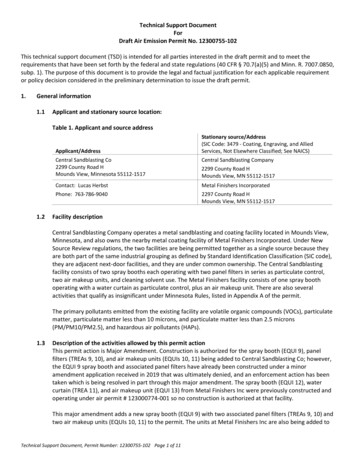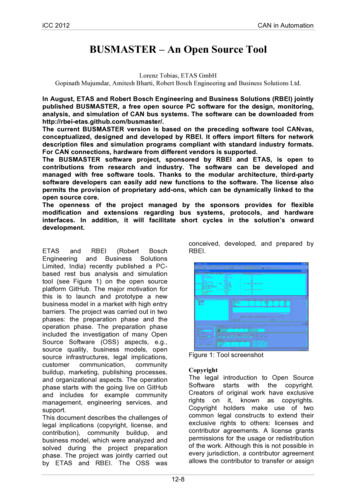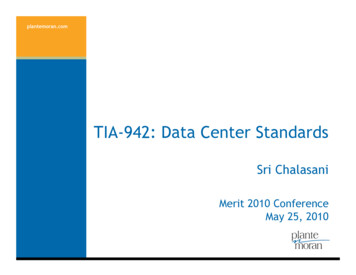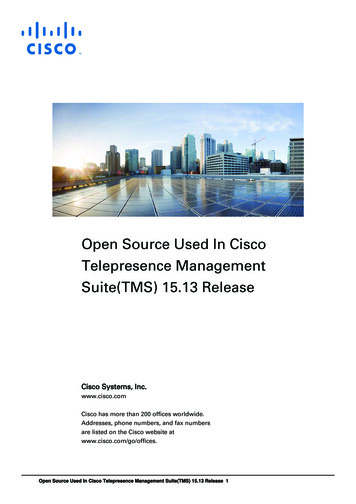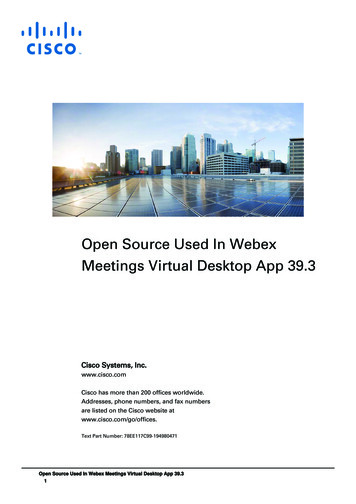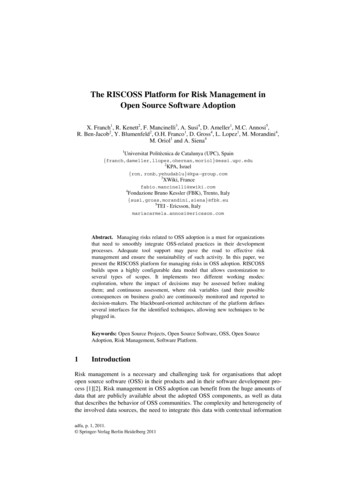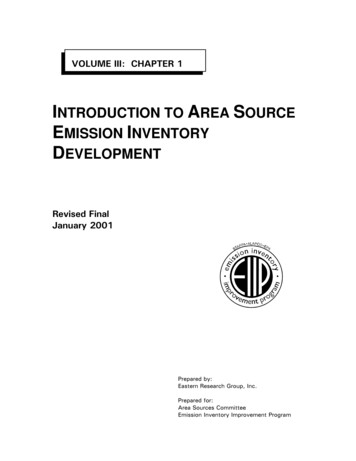
Transcription
INTRODUCTION TO AREA SOURCEEMISSION INVENTORYDEVELOPMENT
DISCLAIMERAs the Environmental Protection Agency has indicated in Emission Inventory ImprovementProgram (EIIP) documents, the choice of methods to be used to estimate emissions depends onhow the estimates will be used and the degree of accuracy required. Methods using site-specificdata are preferred over other methods. These documents are non-binding guidance and not rules.EPA, the States, and others retain the discretion to employ or to require other approaches thatmeet the requirements of the applicable statutory or regulatory requirements in individualcircumstances.
ACKNOWLEDGEMENTThis document was prepared by Eastern Research Group, Inc. for the Area Sources Committee ofthe Emission Inventory Improvement Program and for Charles Mann of the Air PollutionPrevention and Control Division, U.S. Environmental Protection Agency. Members of the AreaSources Committee contributing to the preparation of this document are:Kristin Abraham, West Virginia Department of Environmental ProtectionKwame Agyei, Puget Sound Air Pollution Control AgencyRay Bishop, Oklahoma Department of Environmental QualityDan Brisko, New York State Department of Environmental ConservationOrlando Cabrera-Rivera, Wisconsin Department of Natural ResourcesAndy Delao, California Air Resources BoardLaurel Driver, Emission Factor and Inventory Group, U.S. Environmental Protection AgencyMark Eastburn, Delaware Department of Natural ResourcesCharles Mann, Air Pollution Prevention and Control Division, U.S. Environmental Protection AgencySally Otterson, Washington Department of EcologyKenneth Santlal, Massachusetts Department of Environmental ProtectionWalter Simms, Maryland Department of the EnvironmentJack Sipple, Delaware Department of Natural Resources and Environmental ControlKarla Smith-Hardison, Texas Natural Resources Conservation CommissionAngel Thompson, South Carolina Department of Health and Environmental ControlLee Tooly, Emission Factor and Inventory Group, U.S. Environmental Protection AgencyEIIP Volume III
1/31/01CHAPTER 1 - INTRODUCTIONThis page is intentionally left blank.EIIP Volume III
CONTENTSSection1Introduction . . . . . . . . . . . . . . . . . . . . . . . . . . . . . . . . . . . . . . . . . . . . . . . . . . . . . . . . 1.1-11.11.224Overview of Volume . . . . . . . . . . . . . . . . . . . . . . . . . . . . . . . . . . . . . . . . . . . 1.1-2Definition of Area Sources . . . . . . . . . . . . . . . . . . . . . . . . . . . . . . . . . . . . . . 1.1-3Inventory Planning . . . . . . . . . . . . . . . . . . . . . . . . . . . . . . . . . . . . . . . . . . . . . . . . . . . 1.2-12.12.22.32.42.53PageDefining the Scope . . . . . . . . . . . . . . . . . . . . . . . . . . . . . . . . . . . . . . . . . . . . . 1.2-3The QA Program . . . . . . . . . . . . . . . . . . . . . . . . . . . . . . . . . . . . . . . . . . . . . . 1.2-7Emission Estimation Methods . . . . . . . . . . . . . . . . . . . . . . . . . . . . . . . . . . . . 1.2-9Documentation . . . . . . . . . . . . . . . . . . . . . . . . . . . . . . . . . . . . . . . . . . . . . . . 1.2-10Data Collection/Management . . . . . . . . . . . . . . . . . . . . . . . . . . . . . . . . . . . 1.2-11Emission Estimation Approaches . . . . . . . . . . . . . . . . . . . . . . . . . . . . . . . . . . . . . . . 1.3-13.1Extrapolating from a Sample or other Database . . . . . . . . . . . . . . . . . . . . . . 1.3-33.2Material Balance Method . . . . . . . . . . . . . . . . . . . . . . . . . . . . . . . . . . . . . . . . 1.3-53.3Mathematical Models . . . . . . . . . . . . . . . . . . . . . . . . . . . . . . . . . . . . . . . . . . . 1.3-63.4Emission Factors . . . . . . . . . . . . . . . . . . . . . . . . . . . . . . . . . . . . . . . . . . . . . . 1.3-63.4.1 Emission Factor Accuracy . . . . . . . . . . . . . . . . . . . . . . . . . . . . . . . . . . 1.3-83.4.2 Emission Factor References . . . . . . . . . . . . . . . . . . . . . . . . . . . . . . . . . 1.3-83.4.3 Updating Emission Factors . . . . . . . . . . . . . . . . . . . . . . . . . . . . . . . . 1.3-113.4.4 Emission Factor Calculations . . . . . . . . . . . . . . . . . . . . . . . . . . . . . . 1.3-11Adjustments to Emission Estimates . . . . . . . . . . . . . . . . . . . . . . . . . . . . . . . . . . . . . . 1.4-14.1Accounting for Point Source Emissions . . . . . . . . . . . . . . . . . . . . . . . . . . . . 1.4-14.2Control, Rule Effectiveness and Rule Penetration . . . . . . . . . . . . . . . . . . . . .4.2.1 Control Efficiency . . . . . . . . . . . . . . . . . . . . . . . . . . . . . . . . . . . . . . . .4.2.2 Rule Effectiveness . . . . . . . . . . . . . . . . . . . . . . . . . . . . . . . . . . . . . . . .4.2.3 Rule Penetration . . . . . . . . . . . . . . . . . . . . . . . . . . . . . . . . . . . . . . . . . .4.2.4 Example Showing Application of CE, RP, and RE . . . . . . . . . . . . . . .4.2.5 Temporal Adjustments . . . . . . . . . . . . . . . . . . . . . . . . . . . . . . . . . . . . .4.2.6 Seasonal Activity . . . . . . . . . . . . . . . . . . . . . . . . . . . . . . . . . . . . . . . . .EIIP Volume III1.4-51.4-51.4-51.4-61.4-61.4-81.4-9v
CONTENTS (CONTINUED)SectionPage4.2.7 Activity Days per Week . . . . . . . . . . . . . . . . . . . . . . . . . . . . . . . . . . . 1.4-104.2.8 Calculations for Temporal Adjustments . . . . . . . . . . . . . . . . . . . . . . 1.4-10567vi4.3Spatial Allocation . . . . . . . . . . . . . . . . . . . . . . . . . . . . . . . . . . . . . . . . . . . . . 1.4-164.4Applying Growth Factors for Projections . . . . . . . . . . . . . . . . . . . . . . . . . . 1.4-21Data Collection and Management . . . . . . . . . . . . . . . . . . . . . . . . . . . . . . . . . . . . . . . 1.5-15.1Data Collection and Storage . . . . . . . . . . . . . . . . . . . . . . . . . . . . . . . . . . . . .5.1.1 Data Resources . . . . . . . . . . . . . . . . . . . . . . . . . . . . . . . . . . . . . . . . . . .5.1.2 Data Handling . . . . . . . . . . . . . . . . . . . . . . . . . . . . . . . . . . . . . . . . . . .5.1.3 Data Storage . . . . . . . . . . . . . . . . . . . . . . . . . . . . . . . . . . . . . . . . . . . . .5.1.4 Necessary Data Elements . . . . . . . . . . . . . . . . . . . . . . . . . . . . . . . . . . .5.1.5 Special Issues . . . . . . . . . . . . . . . . . . . . . . . . . . . . . . . . . . . . . . . . . . . .5.1.6 National Emissions Inventory (NEI) Input . . . . . . . . . . . . . . . . . . . .1.5-11.5-11.5-21.5-61.5-71.5-71.5-85.2Surveys . . . . . . . . . . . . . . . . . . . . . . . . . . . . . . . . . . . . . . . . . . . . . . . . . . . . . . 1.5-8Inventory Quality and Uncertainty . . . . . . . . . . . . . . . . . . . . . . . . . . . . . . . . . . . . . . . 1.6-16.1QA/QC Procedures for Area Source Inventories . . . . . . . . . . . . . . . . . . . . . . 1.6-16.2QA/QC for Inventory Calculations . . . . . . . . . . . . . . . . . . . . . . . . . . . . . . . . 1.6-66.3Uncertainty in Area Source Inventories . . . . . . . . . . . . . . . . . . . . . . . . . . . . . 1.6-76.4Variability . . . . . . . . . . . . . . . . . . . . . . . . . . . . . . . . . . . . . . . . . . . . . . . . . . 1.6-106.5Parameter Uncertainty . . . . . . . . . . . . . . . . . . . . . . . . . . . . . . . . . . . . . . . . . 1.6-106.6Model Uncertainty . . . . . . . . . . . . . . . . . . . . . . . . . . . . . . . . . . . . . . . . . . . . 1.6-11References . . . . . . . . . . . . . . . . . . . . . . . . . . . . . . . . . . . . . . . . . . . . . . . . . . . . . . . . . 1.7-1EIIP Volume III
FIGURES AND TABLESFiguresPage1.2-1Communication and Information Sharing During Inventory Preparation . . . 1.2-21.3-1Example Decision Tree for Choosing an Estimation Methodology . . . . . . . 1.3-41.6-1Internal Source Category Consistency and Accuracy Quality ControlChecks . . . . . . . . . . . . . . . . . . . . . . . . . . . . . . . . . . . . . . . . . . . . . . . . . . . . . . 1.6-2TablesPage1.2-1Potential Area Sources of Ozone Precursor Emissions . . . . . . . . . . . . . . . . . 1.2-51.3-1Emission Estimation Models Useful for Area Sources . . . . . . . . . . . . . . . . . 1.3-71.4-1Source Categories that may have Area and Point Source Contributions . . . . 1.4-21.4-2Examples of Area VOC Source Categories Requiring SpecialConsideration when Calculating Emissions . . . . . . . . . . . . . . . . . . . . . . . . . . 1.4-81.4-3Area Source Seasonal Activity Factors and Days per Week for the PeakOzone and CO Seasons . . . . . . . . . . . . . . . . . . . . . . . . . . . . . . . . . . . . . . . . 1.4-111.5-1Activity Data Example Sources for Ozone Inventory . . . . . . . . . . . . . . . . . . 1.5-31.6-1Sources of Uncertainty in Area Source Emission Estimates . . . . . . . . . . . . . 1.6-8EIIP Volume IIIvii
ABBREVIATIONS AND SviiiAlternative Control TechniquesAIRS Facility SubsystemAerometric Information Retrieval SystemAIRS Area and Mobile SubsystemBureau of Economic Analysisbackground information documentClean Air Act Amendments of 1990Chemical Abstract Servicescompact disc read-only memorycontrol efficiencyClearinghouse for Inventories and Emission Factorscarbon monoxidecarbon dioxideControl Technology CenterControl Techniques GuidelinesDepartment of TransportationData Quality ObjectivesEmission Factor and Inventory GroupEnergy Information AdministrationEmission Inventory Improvement Programemission inventory quality assuranceU.S. Environmental Protection AgencyFactor Information Retrieval Systemfile transfer protocolGeographical Information SystemGovernment Printing Officehazardous air pollutantsidentificationLocating and EstimatingLandfill Air Emissions Estimation Modelmaximum achievable control technologymetropolitan planning organizationmetropolitan statistical areaNational Acid Precipitation and Assessment Programnitrogen oxidesNational Pollutant Discharge Elimination SystemOffice of Air Quality Planning and StandardsEIIP Volume III
ABBREVIATIONS AND FEIIP Volume IIIOffice of Research and Developmentparticulate matterpublicly owned treatment worksPrevention of Significant Deteriorationquality assurancequality controlrule effectivenessrate of progressrule penetrationseasonal activity factorSIP air pollutant inventory management systemSuperfund Amendments and Reauthorization Actsource classification codestandard industrial classificationSurface Impoundment Modeling SystemState Implementation PlanStationary Source Compliance Division, now Office of Enforcement andCompliance Assurance (OECA)Toxic Release Inventory SystemTechnical Support Documentstreatment, storage, and disposal facilityUnited StatesU.S. Department of Agriculturevehicle miles traveledvolatile organic compoundsCrosswalk/Air Toxic Emission Factor Databaseix
1/31/01CHAPTER 1 - INTRODUCTIONThis page is intentionally left blank.xEIIP Volume III
1INTRODUCTIONThis chapter is one of a series of documents developed to provide cost-effective, reliable andconsistent approaches to estimating emissions for area source inventories. Multiple methods areprovided in the chapters to accommodate needs of state agencies with different levels ofavailable resources and skills; and different levels of needs for accuracy and reliability of theirestimates. More information about the EIIP program can be found in Volume 1 of the EIIPseries, Introduction and Use of EIIP Guidance for Emissions Inventory Development.Throughout this chapter and other EIIP area source methods chapters, we stress that area sourcecategories should be prioritized by the inventory planners so that resources can be spent on thesource categories that are the largest emitters, most likely to be subject to regulations or arealready subject to regulations, or require special effort because of some policy reason.Prioritization is particularly important for area source inventories, because in some cases, adifficult to characterize source category may contribute very little to overall emissions andattempting a high quality estimate for that source category may not be cost effective.EIIP chapters are written for the state and local air pollution agencies, with their input andreview. EIIP is a response to EPA’s understanding that state and local agency personnel havemore knowledge about their inventory area’s activities, processes, emissions, and availability ofinformation; and require flexible inventory methods to best use their sometimes limitedresources. These EIIP area source chapters are written as a set of options presented to inventoryprofessionals capable of using their own experience and judgement to apply the method that bestfits their overall needs and constraints.Emissions from area sources are an important component of regional air pollution inventories.With the passage of the Clean Air Act Amendments (CAAA) in November 1990, the need forspecific and standardized procedures for the preparation of area source inventories hasincreased. Over the years, the United States (U.S.) Environmental Protection Agency (EPA)Office of Air Quality Planning and Standards (OAQPS) has established several standardprocedures for the preparation of State Implementation Plan (SIP) emission inventories. TheEmission Inventory Improvement Program's (EIIP's) Area Sources Committee has sought toupdate and expand the EPA guidance through the development of this guidance document. Theobjectives of Volume III, Area Sources, are to: EIIP Volume IIIEstablish standard procedures for the preparation of area source emissioninventories;1.1-1
CHAPTER 1 - INTRODUCTION1/31/01 Present preferred and alternative methods for estimating emissions from selectedarea source categories; and Describe new and innovative emission estimation methods in addition to methodsthat have been commonly used.1.1 OVERVIEW OF VOLUMEThis chapter describes the process of planning and developing an area source inventory.Fundamental emission estimation approaches for area sources as well as data management,quality assurance, and documentation requirements are described. Subsequent chapters presentpreferred and alternative methods for specific area source categories, and include new andinnovative estimation methods whenever they are available. Methods chapters in this volumedescribe and recommend procedures for estimating emissions from an area source category.Each methodology chapter is divided into eight sections.In this chapter: Section 1 outlines the contents of this chapter and defines the area sourcecategory. Section 2 describes the planning process involved in developing an inventory. Section 3 provides an overview of available emission estimation approaches. Section 4 provides details on how to make adjustments to the emission estimates,and Section 5 discusses data management. Section 6 discusses the quality and uncertainty associated with each method. Section 7 is the reference section.In addition, technical abstracts providing limitated amounts of information are available fordownloading from the EIIP Website www.epa.gov/ttn/chief/eiip. When it was recognized thatinventory preparers needed assistance with a particular source category, yet limited informationexisted, that information was compiled into a brief technical document describing the categoryand how to estimate emissions. These documents are called abstracts.1.1-2EIIP Volume III
1/31/01CHAPTER 1 - INTRODUCTION1.2 DEFINITION OF AREA SOURCESAn area source may be defined as a collection of similar emission units within a geographicarea. Commonly, area sources have been defined at the county level, and most area sourcemethods are designed to estimate area source emissions at the county level. However, anyspecified area (e.g., city, town, or census division) could be used to define an area source.User-defined areas such as grid cells or polygons could also be used.Area sources collectively represent individual sources that are small and numerous, and thathave not been inventoried as specific point, mobile, or biogenic sources. Individual sources aretypically grouped with other like sources into area source categories. These source categoriesare grouped in such a way that they can be estimated collectively using one methodology. Forexample, gasoline stations and dry cleaning establishments are often treated as area sources.The main reason not to treat them as point sources is that the effort required to gather data andestimate emissions for each individual facility is great although emissions per facility aregenerally small. For these sources, the distinction between point and area is usually defined by acutoff point typically based on annual emissions. SIP ozone inventories, for example, definevolatile organic compound (VOC) point sources as individual facilities emitting more than10 tons of VOCs per year. Emissions from smaller facilities are treated as an area-source group.True area-wide sources, such as pesticide use and commercial/consumer product use, areexamples of this source type. The boundaries of the individual activities associated with thesesources are often hard to determine or are, at best, arbitrary. Even within a point source facility,some activities occur that are more easily treated as area source emissions. Some emissionsassociated with surface coating operations such as equipment cleaning, for example, can bemore practically estimated using area source methods even though other surface coatingemissions may be reported as part of the point source inventory.The main distinction between point and area sources is the methodology used to estimateemissions. Point sources are inventoried individually, and area sources are inventoriedcollectively. While all stationary sources could be treated as either point sources or areasources, for practical reasons some cutoff is usually set to distinguish between them. The enduse of the inventory, the desired accuracy of the emissions, and the resources available forinventory development all affect where that cutoff is set. Volume III of this EIIP series providesguidance for area source emissions estimation methods for many common area source processes.The term “process” is used here to name an operation or activity that produces emissions. Areasources include the following broad groups of processes: EIIP Volume IIICommercial and consumer organic solvent usage (surface coating, dry cleaning,degreasing, graphic arts, rubber and plastics);1.1-3
CHAPTER 1 - INTRODUCTION1/31/01 Stationary fuel combustion (heating, including waste oil combustion); Material storage and distribution; Waste treatment and disposal; Miscellaneous industrial manufacturing operations; Comfort and industrial cooling towers; Miscellaneous sources (agricultural/forest burning, structure fires, mining orconstruction, for example); Gasoline service stations; and Hospital and laboratory sterilizers.Each of these broad groups of processes contain a number of more specific groups that sharesimilar emission processes and emission estimation methods.Although mobile and biogenic sources could be inventoried as area sources, specialized methodshave been developed for these categories. These methods are described in EIIP Volumes IV andV, respectively.Finally, in this volume of EIIP documents, ozone precursors and the criteria pollutant particulatematter (PM) are emphasized. Where it was possible, emission factors or speciation profiles forother criteria pollutants, hazardous air pollutants (HAPs), and greenhouse gases were included.However, the lack of information for other pollutants in these methodologies should not beconstrued to mean that a source does not emit those pollutan
inventory preparers needed assistance with a particular source category, yet limited information existed, that information was compiled into a brief technical docume
